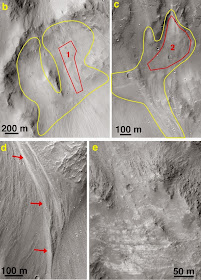Hydrated minerals (minerals
containing water) are considered to be evidence of the former presence of
liquid water on Mars. They have been observed at a number of locations on the
planet, and seem to have been formed in a number of phases, with the oldest, Noachian,
deposits (thought to be approximately 4100 to 3700 million years ago) frequently containing hydrated phyllosilicates, younger, Hesperian
deposits (from about 2700 million years ago to between 3200 and 2000 million years ago) containing hydrated sulphates and the youngest, Amazonian,
deposits (anything younger than Hesperian) containing hydrated ferric oxides. A variety of hydrated
minerals have previously been detected in the Valles Marineris (Mariner
Valley), the largest canyon system on Mars, where the central portion contains
extensive hydrated sulphate deposits, and hydrated clays, silicates and iron
minerals have also been observed.
In a paper published in the
journal Geophysical Research Letters on 30 December 2014, Catherine Weitz of
the Planetary Science Institute, Janice Bishop of the SETI Institute, Leslie Baker
of the Department of Geological Sciences at the University of Idaho and Daniel Berman,
also of the Planetary Science Institute describe the discovery of iron rich
allophane or opal deposits (hydrated silicates) in the Coprates Chasma region
of the central Valles Marineris.
(Top) Mars Orbiter Laser Altimeter topography overlain on Thermal Emission Imaging System (THEMIS) daytime infrared mosaic of central Valles
Marineris, including Melas, Coprates, and Eos chasmata. The yellow rectangle
indicates the location of the bottom left figure. (Bottom left) Portion of HRSC
image H0438_0000_ND4 showing Coprates Chasma. The yellow rectangle identifies
the location of study region and bottom right figure. (Bottom Right) Portion of
CTX image P18_008141_1647 with CRISM spectral parameters derived from image
HRL0000A8F6 overlain in colour (red is olivine index, green is band depth at
1.9 μm, and blue is doublet between 2.2 and 2.3 μm). The Fe-rich allophane/opal
deposits are outlined in yellow, whereas blue lines outline smectite exposures.
Weitz et al. (2014).
Allophane and opal are
semi-amorphous hydrated aluminium silicates, which generally form as weathering
products of volcanic rocks on Earth. They are considered to be quite unstable,
particularly in their high-iron forms, which tend to break down into iron rich
clays. While chemical weathering processes on Mars are thought to be slower
than on Earth, it is still unlikely that these minerals could have persisted at
the surface for very long periods of time, suggesting that they have either
been formed recently (in geological terms) by the action of water, or have been
recently exposed by active geological movements, either of which would be a
significant discovery.
Expanded views of the areas outlined by black boxes in the bottom right
image above. (b and c) Hydrated nanophase Fe-rich allophane/opal corresponds to
materials within yellow outlines. Portion of HiRISE images ESP_033010_1645 and
PSP_008141_1645. (d) Channel containing Fe-rich allophane/opal (red arrows).
Portion of HiRISE image PSP_008141_1645. (e) Example of smectites along the
wall rock. Weitz et al. (2014).
The Coprates Chasma region is
interpreted as a graben structure, which is to say an area where rock movements
have drawn two areas of planetary crust apart, resulting in thinning of the
crust in the central area, which in turn tends to lead to subsidence and
slumping. The allophane/opal deposits are exposed on an area of slumping
(landslips) thought to be in the region of 50-100 million years old. It is
unclear if these minerals predated this slumping, and have been exposed by it,
thereby potentially representing a greater reserve buried beneath the surface,
or whether they are younger material that has formed at the surface as the
result of the weathering of other minerals exposed by the slumping.
HiRISE DTMperspective view at 2X vertical exaggeration with CRISM
spectral parameters overlain in colour (red is olivine index, green is band
depth at 1.9 μm, and blue is doublet between 2.2 and 2.3 μm). The red arrows
identify the eastern Fe-rich allophane/opal deposit (whitish blue), which
extends across 940m in elevation, whereas the green arrows identify exposures
of smectites within the wall rock (yellow-light green). HiRISE stereo pair
images PSP_008141_1645 and PSP_007785_1645 were used to make the DTM. Weitz et al. (2014).
See also…
Landslides on Mars typically have much greater runout distances than those on Earth, due to the planets lower gravity and thinner atmosphere. This can lead to areas of layered deposits from different landslides quite distant from the source, particularly within the larger canyons on Mars. Since it is possible to produce approximate ages for such deposits based upon the number of impact...
The surface of Mars has been observed continuously by the Mars Orbiter Camera from 1997 to 2006 and the Mars Reconnaissance Orbiter since 2006. During the time that these observations have been occurring around 200 new impact craters have been observed on the surface of the planet; most of them in dusty areas, where they are easily detected due to the dark blast patterns that surround fresh impacts in these...
The potential of there being life on Mars has been a stalwart of popular fiction for over a century, though to date no signs of actual life have been discovered. Recent discoveries of geological structures on Mars that indicate the presence of large bodies of open water in the early history of the planet. This new understanding of the planet makes the search for evidence of ancient life on Mars a more realistic...
Follow Sciency Thoughts on
Facebook.






